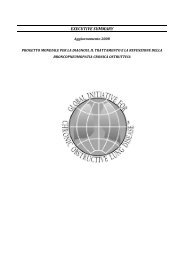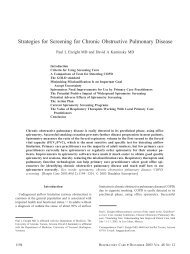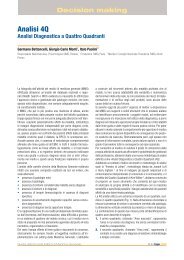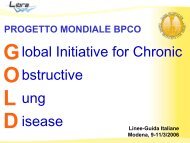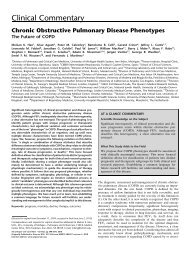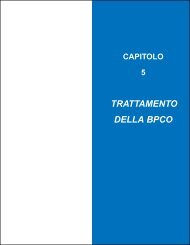Efficacy and safety of NVA237 versus placebo and ... - GOLD
Efficacy and safety of NVA237 versus placebo and ... - GOLD
Efficacy and safety of NVA237 versus placebo and ... - GOLD
Create successful ePaper yourself
Turn your PDF publications into a flip-book with our unique Google optimized e-Paper software.
E. KERWIN ET AL. COPD<br />
TABLE 3<br />
Most frequent adverse events (o3% in any treatment group), serious adverse events occurring in o3 patients in either<br />
group, deaths <strong>and</strong> discontinuations due to adverse events <strong>and</strong> electrocardiographic abnormalities<br />
<strong>NVA237</strong> 50 mg q.d. Placebo Tiotropium 18 mg q.d.<br />
Subjects n 525 268 267<br />
Patients with adverse events 402 (76.6) 205 (76.5) 198 (74.2)<br />
COPD worsening # 191 (36.4) 116 (43.3) 90 (33.7)<br />
Upper respiratory tract infection 57 (10.9) 33 (12.3) 30 (11.2)<br />
Nasopharyngitis 47 (9.0) 15 (5.6) 21 (7.9)<br />
Sinusitis 28 (5.3) 14 (5.2) 10 (3.7)<br />
Upper respiratory tract infection, bacterial 28 (5.3) 28 (10.4) 21 (7.9)<br />
Back pain 25 (4.8) 10 (3.7) 12 (4.5)<br />
Headache 25 (4.8) 14 (5.2) 12 (4.5)<br />
Lower respiratory tract infection 23 (4.4) 9 (3.4) 10 (3.7)<br />
Bronchitis 22 (4.2) 10 (3.7) 12 (4.5)<br />
Cough 21 (4.0) 13 (4.9) 12 (4.5)<br />
Hypertension 21 (4.0) 12 (4.5) 14 (5.2)<br />
Dry mouth 16 (3.0) 5 (1.9) 4 (1.5)<br />
Dyspnoea 14 (2.7) 13 (4.9) 6 (2.2)<br />
Pneumonia 14 (2.7) 12 (4.5) 7 (2.6)<br />
Urinary tract infection 14 (2.7) 8 (3.0) 16 (6.0)<br />
Peripheral oedema 9 (1.7) 6 (2..2) 8 (3.0)<br />
Upper respiratory tract infection viral 9 (1.7) 13 (4.9) 11 (4.1)<br />
Patients with serious adverse events 66 (12.6) " 43 (16.0) 41 (15.4) "<br />
COPD worsening # 19 (3.6) 16 (6.0) 13 (4.9)<br />
Pneumonia 7 (1.3) 7 (2.6) 4 (1.5)<br />
Atrial fibrillation 4 (0.8) 0 0<br />
Dehydration 4 (0.8) 2 (0.7) 0<br />
Syncope 3 (0.6) 1 (0.4) 0<br />
Transient ischemic attack 3 (0.6) 1 (0.4) 0<br />
Bronchitis 3 (0.6) 1 (0.4) 0<br />
Deaths 3 (0.6) + 2 (0.7) 2 (0.7)<br />
Discontinuation due to adverse events 42 (8.0) 31 (11.6) 20 (7.5)<br />
Electrocardiographic abnormalities<br />
Total notable 23 (4.4) 16 (6.0) 14 (5.3)<br />
QTc .500 ms 2 (0.4) 2 (0.7) 0<br />
Increase from baseline <strong>of</strong> 30–60 ms 83 (15.8) 39 (14.6) 43 (16.2)<br />
Increase from baseline <strong>of</strong> .60 ms 1 (0.2) 1 (0.4) 0<br />
Data are presented as n (%), unless otherwise stated. # : includes chronic obstructive pulmonary disease (COPD) exacerbation; " : includes one serious adverse event in<br />
the 30-day follow-up period; + : includes one death in the 30-day follow-up period.<br />
GLOW2 study, the open-label nature <strong>of</strong> the comparison with<br />
tiotropium could have mildly influenced the results <strong>of</strong> the<br />
patient-reported outcomes or rescue medication usage. However,<br />
the primary <strong>and</strong> the majority <strong>of</strong> the secondary efficacy<br />
objectives in the GLOW2 study were based on spirometric endpoints,<br />
with comparable results seen in the <strong>NVA237</strong> <strong>and</strong> the<br />
tiotropium treatment groups, including serial spirometry in a<br />
subpopulation <strong>of</strong> patients, which demonstrated comparable<br />
efficacy pr<strong>of</strong>iles for <strong>NVA237</strong> <strong>and</strong> tiotropium at week 12. Spirometry<br />
is considered to be an objective, st<strong>and</strong>ardised <strong>and</strong><br />
reproducible measure <strong>of</strong> airflow limitation, <strong>and</strong> is not likely to<br />
be subject to bias. Furthermore, the results obtained in the<br />
GLOW2 study for tiotropium <strong>versus</strong> <strong>placebo</strong> in terms <strong>of</strong><br />
improvements in lung-function, TDI <strong>and</strong> SGRQ scores were<br />
consistent with results from other r<strong>and</strong>omised <strong>placebo</strong>-controlled<br />
trials using blinded tiotropium [23–30].<br />
It may be pointed out that although the magnitude <strong>of</strong><br />
improvement observed in trough FEV1 with tiotropium <strong>versus</strong><br />
<strong>placebo</strong> was comparable to the improvement seen with<br />
tiotropium in recent r<strong>and</strong>omised tiotropium trials [23–26], it<br />
was lower than the improvement observed in earlier such<br />
studies [27–29]. Some <strong>of</strong> the possible explanations could include<br />
differences in baseline demographics <strong>of</strong> patient population, shift<br />
in the baseline characteristics <strong>of</strong> patients entering trials due to<br />
benefits obtained from the variety <strong>of</strong> short- <strong>and</strong> long-acting<br />
bronchodilators currently available, as opposed to the limited<br />
options available previously, <strong>and</strong> selective recruitment due to<br />
the impact <strong>of</strong> concomitant medications permitted [31].<br />
The results for <strong>NVA237</strong> 50 mg q.d. <strong>versus</strong> <strong>placebo</strong> in the GLOW2<br />
study were comparable to those for tiotropium, suggesting that<br />
<strong>NVA237</strong> 50 mg q.d. has the potential to be a useful alternative to<br />
tiotropium.<br />
c<br />
EUROPEAN RESPIRATORY JOURNAL VOLUME 40 NUMBER 5 1113




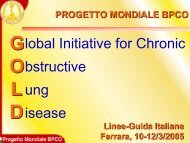
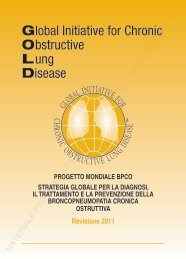
![Di Bari [NO].pdf - GOLD](https://img.yumpu.com/21544924/1/190x143/di-bari-nopdf-gold.jpg?quality=85)

